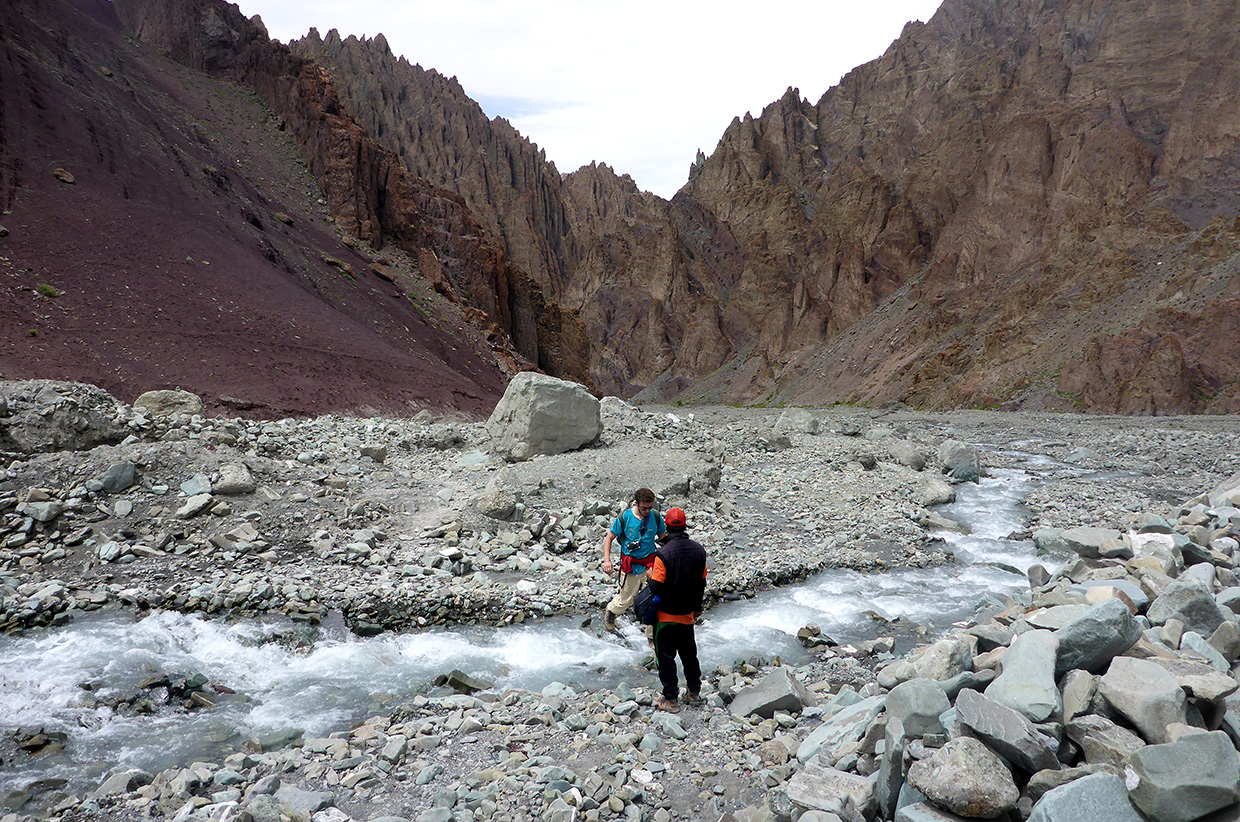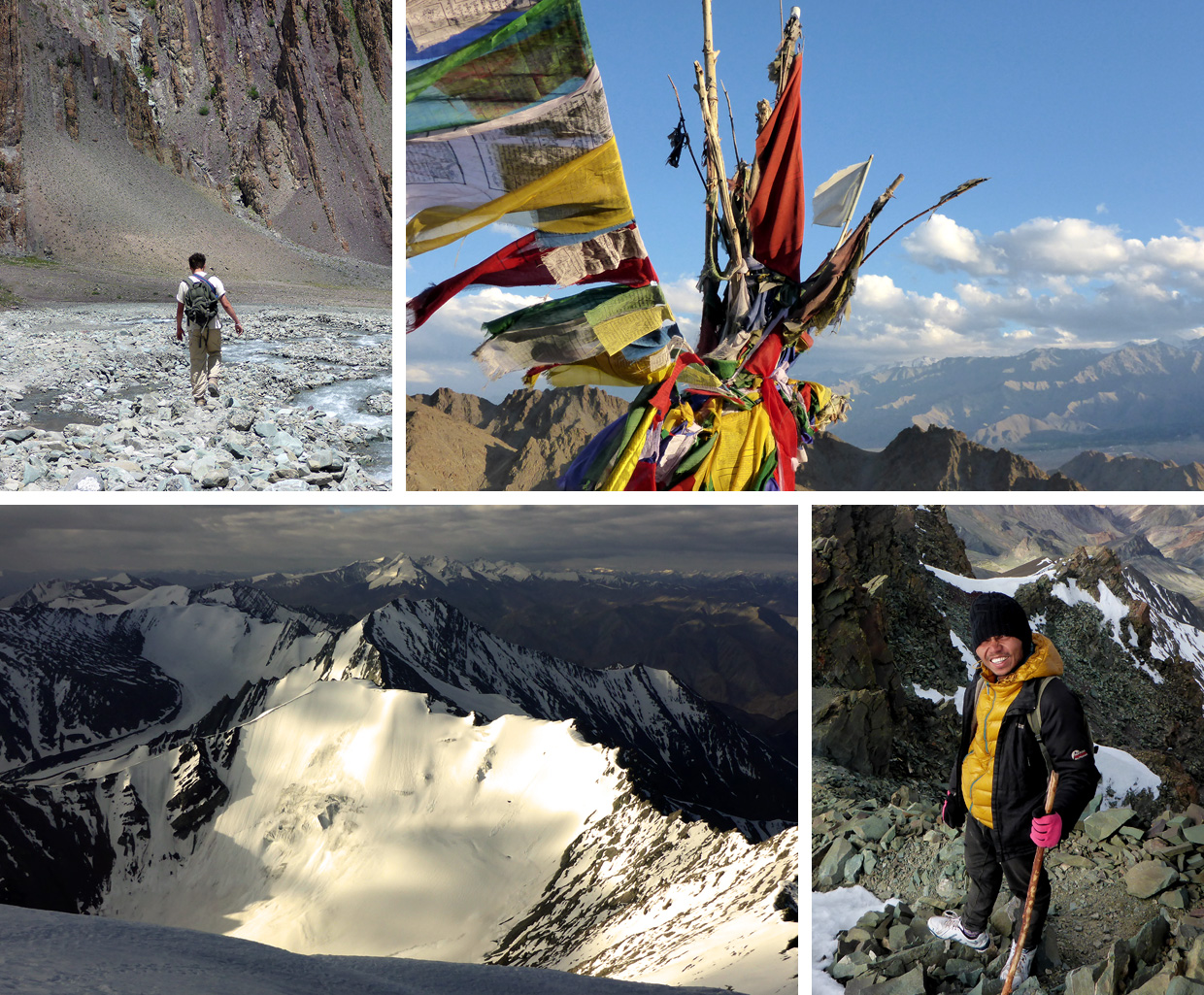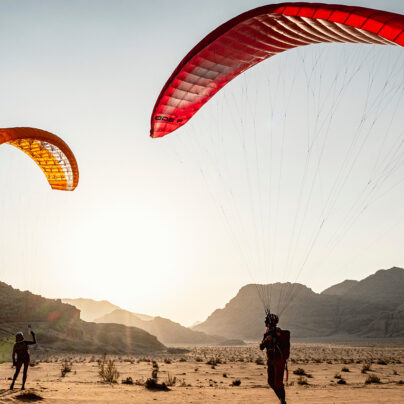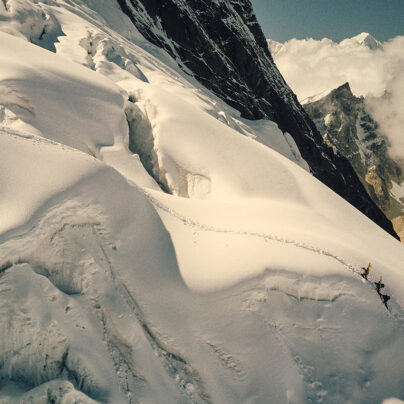The Makeshift Mountaineer
Julian Oldmeadow
Otsal, my young Ladakhi guide, already had a bounce back in his step and he jumped around in his tennis shoes grinning madly, obviously delighted to have guided a successful ascent. It might have punctured my sense of achievement – me with my ice axe, plastic Koflach boots and crampons, him with his makeshift walking stick, tracksuit pants and tennis shoes – but I didn’t care. I was standing on a mountaintop in the Indian Himalaya, 6,153m above sea level and nothing could dampen the joy.
To the north we could see fertile green patches along the Indus River, far below. To the east, a prominent cluster of high mountains stood out; one of them K2, the world’s second highest summit. To the west, the slope fell sharply away under a cornice of ice, all the way down to the valley floor. Standing precariously close to this edge in his tennis shoes, Otsal described how one climber had fallen to his death down this side. ‘It’s impossible to fall off mountains, you fool!’ Ray had claimed in Kerouac’s Dharma Bums. ‘Perhaps,’ I thought, ‘but you can certainly fall down them.’ I took a step back to the safety of the plateau.
Stok Kangri rises above the town of Leh in the North Indian state of Jammu and Kashmir, in a region known as India’s ‘Little Tibet’. It’s reputed to be the easiest 6000m peak in the world and touted by local guides as a ‘baby trek’. True, it isn’t technically difficult, but there’s nothing ‘baby’ about a 6000m mountain, and many unsuspecting travellers find this out the hard way. Trekking in Ladakh is, compared to Nepal or South America, still relatively under-developed. Tour operators based in Leh offer cheap treks through Zanskar, the Markha valley, and up Stok Kangri. The treks are sold out of small shopfronts along the traveller’s area of Changspa Road, where would-be trekkers are enticed in by signs proclaiming urgently: ‘Two or three more people needed for expedition to Stok leaving tomorrow’. The various shops coordinate and when they’ve found enough people they set up a trek with a few horses and a local guide. That’s how I came to join my ‘expedition’.
To the north we could see fertile green patches along the Indus River, far below. To the east, a prominent cluster of high mountains stood out; one of them K2, the world’s second highest summit. To the west, the slope fell sharply away under a cornice of ice, all the way down to the valley floor.

At eight in the morning on the next day, a minibus arrived and I met Larry, a young pale-faced English lad, studying psychology at Goldsmiths. There was no sign of the other two would-be mountaineers who were supposed to be joining us. We were told they would meet up with us tomorrow, but I suspected they’d pulled out or, perhaps, had never even existed in the first place. Sacks of gear were thrown on the roof amidst assurances that all was taken care of. We were about to set off when Larry suddenly asked ‘Hey, is there anywhere I can buy a pair of sunglasses around here?’ The slick-haired businessman, who had sold the trek to Larry, offered him his own. ‘Here. Take mine. You can give them back at the end.’
I pulled my too-big plastic Koflachs and a pair of old crampons out from the hessian sack. Otsal jumped in and started trying to fit them, and I quickly realised that he didn’t know how to put them on. I asked him about his own and he said he’d be climbing in his tennis shoes. By now I wasn’t surprised.
By the time we reached base camp around midday on day two I was starting to have doubts about the credibility of our little party. Larry had taken three hours to cover the few kilometres that lay between our drop off point and base camp, and was complaining of a thumping headache, while Jimmy seemed no more qualified as a mountain guide than the boy from the local village, which is pretty much what he was. Adding to my concerns were the thick grey clouds hanging over the mountains, that and the few returning climbers we passed on the way, who all just shook their heads despondently when we asked them how they’d got on. To some relief, at base camp we met Otsal, a friend of Jimmy’s and fellow guide who would accompany us on the summit attempt. Apparently he had climbed Stok Kangri thirty times and K2 once, though I had my doubts. Still, I was relieved that Larry and I would have a guide each so that, selfishly, my success would be somewhat decoupled from his.
In the afternoon we got together to discuss the ‘plan’ and do a kit check. We would start at midnight, with the aim of reaching the top for sunrise. I pulled my too-big plastic Koflachs and a pair of old crampons out from the hessian sack. Otsal jumped in and started trying to fit them, and I quickly realised that he didn’t know how to put them on. I asked him about his own and he said he’d be climbing in his tennis shoes. By now I wasn’t surprised. I asked Jimmy about a torch and he glanced at me with a look of mild panic. ‘You no have?’ He asked. I sighed and told him not to worry. I had a head torch, I just didn’t know how much battery was left. So much for everything being taken care of. Larry didn’t have any gloves and was saying it’d be fine. I said it wouldn’t be fine and told him to go and borrow some from an Indian group who were waiting an extra day at base camp to acclimatise.
We set off a little after midnight, making our way by torchlight up and over the shale ridge that separated base camp from the lower flanks of the peak. Thankfully, the sky was clear and the stars were thick. The Milky Way stretched like a cloud across the night’s canopy and shooting stars streak brightly in the darkness. Larry kept up for a while but soon called for rest stops and then complained of feeling ill. Jimmy and Otsal took off ahead in places, leaving me to fall back to help Larry across the various sections of snow that lay across the steep slope. At one point Jimmy slipped and slid down to the bottom of the slope, unhurt apart from his pride. The guides were throwing their torchlight here and there, searching for the way, and at various points took a clearly suboptimal route were even I could see a better one.

Larry’s calls for rest increased in frequency, and we waited impatiently for him to catch his breath. We reached the other side of the glacier where the ground kicked up steeply on loose shale and snow. Within a few minutes Larry called out from behind that he thought he had to stop. He had fallen over three times and was starting to see multi-coloured shapes blister in front of his eyes. I was in no doubt that his climb was over and called up to Jimmy to stop and go back with him. Jimmy came down reluctantly and asked whether Larry had any Diamox. Luckily he didn’t, so there was no excuse not to go back down. Jimmy and Larry started down, while Otsal and I carried on towards the summit.
I sat with Larry for a long time and we chatted things through. I empathised with him, but tried also to put the whole thing in perspective. These two guys were doing the best they could, given they were just two local boys trying to make a living by ‘guiding’ people up a mountain. They had no training, paltry equipment, and were being paid pittance for it. Jimmy would be feeling embarrassed and sorry that he’d gotten lost, even if he couldn’t say as much. If Larry wanted to be pissed off with someone, I suggested, it should be the slick-haired businessman who sold him this trip as a well-organised, well-supported and safe trek up an ‘easy’ mountain. For my part, I didn’t feel like being pissed off with anyone. Now safe at base camp, I felt like smiling at the craziness of the ascent, breathing in its rawness, and being thankful that there are still places in the world where you can stumble upon a slapstick adventure just like this.

Julian Oldmeadow has a passion for adventure, whether its firing makeshift guns on the North West Frontier of Pakistan, getting lost on an Enfield in the Thar Desert of India, or cycling over the Himalaya. His preferred mode of transport is bicycle, by which has travelled Morocco, India, Scotland and Burma. When not travelling he is an academic psychologist, and occasionally works as a cycle touring guide for Redspokes.
Email: [email protected]






